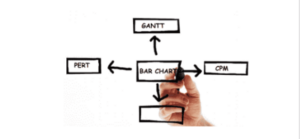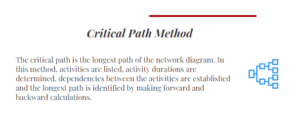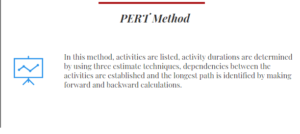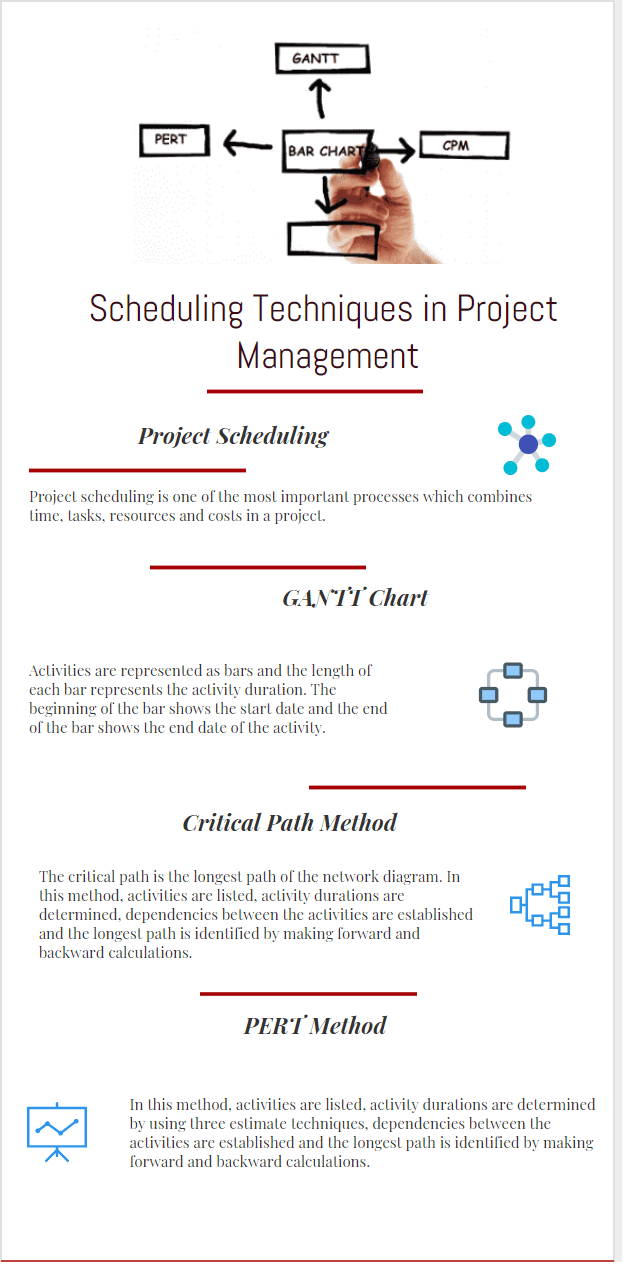Project management teams use various tools and techniques to create work schedules and measure the performance of their projects. Project scheduling is one of the most important processes which combines time, tasks, resources, and costs in a project. Basically, work schedules are created by listing the activities, determining activity durations, and assigning activity relationships. Gantt Charts, PERT Charts, and CPM are the most common project planning and scheduling techniques and methods used for creating work schedules. One or all of these network scheduling techniques can be used based on the requirements and the complexity of the project.
Table of Contents
In this article, we will take a glance at the most common planning and scheduling techniques in project management.
Importance of Using Network Scheduling Techniques
A project schedule creates a roadmap to plan and manage major deliverables of a project. Therefore having a complete and proper project schedule in place demonstrates what you have to do in the next period. You can easily highlight the logical relationships of activities, major project milestones that must be achieved under a given deadline.
By employing the right scheduling methods, you can manage the sequence of activities, tasks, and project scope and take actions when needed in your project. By assigning the resources to the schedule, you can also detect the overloads and make resource leveling. Therefore, project schedule management is vital for the success of any project.

Most Common Project Planning and Scheduling Techniques
GANTT Chart
Gantt Charts are also known as bar charts. Activities are represented as bars and the length of each bar represents the activity duration. The beginning of the bar shows the start date and the end of the bar shows the end date of the activity. Depending on the project execution plan and resource availability, these bars may be sequential or run in parallel. Gantt Charts are simple tools, therefore, project teams and stakeholders can easily understand the plan and manage their projects with the help of them.
Gantt Chart is the most frequently used scheduling technique because of its simplicity. However, without using software it is difficult to update activities, activity relationships and manage changes as the project progresses.
Everybody can create a Gantt Chart and insert activities even with the help of a spreadsheet. If you don’t know how to create a Gantt Chart, you can read this article from here: Gantt Chart Example

Critical Path Method (CPM)
The critical path method is an advanced project scheduling technique that was developed in the late 1950s. Then it has been used for the scheduling of any type of projects including construction, aerospace and defense, software development, IT, etc. In this method, activities are linked to each other by using dependencies in a network diagram. These activity groups form paths.
The critical path is the longest path of the project network diagram. In this method, activities are listed, activity durations are determined, dependencies between the activities are established and the longest path is identified by making forward and backward calculations. The critical path method is a visual technique that enables to show activities, activity dependencies, and durations in the same diagram.
It is a common method for determining the completion date of a project. However, it is difficult to determine the critical path of a large and complex project without using the software. Employing software like Primavera P6 or Microsoft Project helps to analyze the critical path of a project which may include thousands of activities and relationships.
For more details, you can read this article: Critical Path Method regarding the use of this technique.

PERT Method
PERT Method is one of the most common project network scheduling techniques. PERT stands for Program Evaluation Review Technique. It was developed by the US Navy in the late 1950’ s for Ballistic Missile Program in order to find a simple system to manage and organize complex objectives and thousands of contractors.
In this method, activities are listed, activity durations are determined by using three estimate techniques, dependencies between the activities are established and the longest path is identified by making forward and backward calculations.
The three estimate techniques are;
• Most Likely Estimate
• Optimistic Estimate
• Pessimistic Estimate
Simply put, the most likely estimate refers to the most possible time required to complete the task. Optimistic Estimate refers to the shortest time required to complete the task. Pessimistic Estimate refers to the longest time required to complete the task. The expected time of the task is calculated by using these three estimates.
In PERT Method, project completion time relies on the calculation of the expected duration for each activity. The critical path method is used in conjunction with the PERT Method. You can determine the critical path of the project by performing forward, backward calculations. However PERT is a time-consuming method that requires software to implement. If you want to learn more, you can read this article related to the usage of the PERT Method.

Project Schedule Management Process
Project Schedule Management involves practices, methods, and project scheduling techniques to successfully complete a project on time. Before creating a schedule, the project team prepares preliminary studies such as estimating activity durations, creating the work breakdown structure (WBS), preparing resource lists, and deciding resource usage limits as well as surveying availability for each type of resource. Since a schedule itself contains many estimates, it should be created by using a consensus-driven estimation method. Because making estimations requires expert knowledge. Otherwise, the schedule could be unrealistic.
After setting the overall schedule, the project manager and project team begins monitoring and controlling the performance. In order to obtain stakeholder’s support and facilitate project works, the project manager informs all the participants regarding the current project status.
Basically, the project schedule management process aims to create a complete, reliable, and an accepted schedule.
Project Schedule Management Steps
The project schedule management process includes the following steps;
- Defining
- Publishing
- Monitoring & Controlling
Below are the inputs of the project schedule management process;
- WBS (Work Breakdown Structure)
- Organizational Process Assets (Historical information & Lessons learned, etc.)
- Expert knowledge
- Project Scope
- Project Objectives
- Calendar information
- Milestones, deadlines
- Constraints (contractual or other project const.)
- Enterprise Environmental Factors (risks, law and regulations, etc.)
- Resource Information (resource availability, resource limits, resource calendars, etc.)
The output of the project schedule management process is the project schedule.
Let’s go deeper into each step.
Defining the Project Schedule & Scheduling Technique
Defining the Project Schedule step begins with creating the Work Breakdown Structure. At this step, you will also decide which scheduling technique will be used. A well prepared WBS affects the quality of the whole schedule. Preparation of the activity lists comes after that. Project Scope, design documents, and the stakeholder’s requirements are analyzed and the activity lists are prepared considering all the project objectives.
The project team assigns logical relationships to the activities by using four types of relationships (FS, SS, SF, FF). If the relationships are assigned incorrectly, the project network diagram will show an incorrect critical path.
After that step, estimate activity duration process comes into play. Duration is the amount of time spent to complete an activity. Estimate Activity Durations is the process of estimating the amount of time required to complete an activity considering the resources. Below are six tools to estimate activity duration;
1. Expert Judgment
2. Analogous Estimating
4. Three-Point Estimates
5. Reserve analysis
6. Group Decision Making Techniques
Finally, with the help of project scheduling techniques, the project network diagram is created and the critical path is calculated by the team. Once the draft project schedule is created, the project manager reviews the activities and the critical path in order to understand if it reflects the conditions. If the critical path is incorrect or the activity relationships or durations are assigned incorrectly, the schedule will be revised before submitting and receive final approval.
Publishing the Project Schedule
After creating the schedule, project teams, key project stakeholders, and beneficiary representatives come together to make negotiations. If they agree on the dates, milestones, and structure, the schedule will be approved, published, and stored as a baseline for monitoring and controlling purposes.
As the project progresses, the project team updates the schedule by using the information coming from the activity reports. During this step, actual start dates, actual finish dates, and percent completion rates are inserted for each activity that has actuals. Sometimes remaining activity durations can be inserted instead of inserting percent completion rates.
Publishing and updating the project schedule step provides the project manager by necessary information regarding the general status of the major project deliverables.
Monitoring & Controlling the Project Schedule
Monitoring and controlling the project schedule aims at evaluating the current status of the project by making performance management calculations. Performance management calculations include the following;
- Earned Value Analysis
- Schedule Variance
- Cost Variance
According to the reports, if the schedule is deviating from the original plan, the project manager and the team members decide to use schedule compression techniques to bring the schedule back to the original plan if possible. Sometimes delays do not affect the project’s milestones. For example, an activity delayed 10 days compared with the actual plan, but if it is not on the critical path and does not affect anything, no action will be required.
Summary
In this article, we discuss the three most common network scheduling techniques in project management. Basically, Gantt Charts are the simplest methods used for creating work schedules. However, the critical path and the project completion date can not be determined by using simple Gantt Charts. The critical path is determined by identifying the longest stretch of dependent activities within a work schedule. The critical path method demonstrates the project completion date and the activities on the critical path. The PERT method is a complicated method which makes it hard to analyze the results. Employing software enables to create project work schedules, CPM and PERT calculations easier and fastly.
External References

Linda Maltz is vice president of design and consulting at Cuboca, a project management training and consulting organization specializing in construction management and BIM. She is certified Primavera P6 Trainer.















